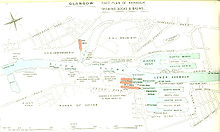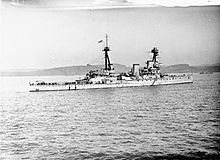Fairfield Shipbuilders
Fairfield Shipbuilders , often abbreviated as Fairfields , is a shipyard based in Govan , Glasgow , on the River Clyde in Scotland . The shipyard was best known for the construction of numerous warships.
history
Start time
The shipyard in Govan in 1860 by Charles Randolph, founded John Elder as Randolph, Elder & Co . The predecessor company Randolph & Elliot manufactured machines in the Tradeston District. The first ship, the Colon , was built in 1861 without a hull number, the second, the MacGregor Laird , got hull number 14. As early as 1868 the company moved to new premises at Fairfield Farm and in 1870 it became John Elder and Company . John Elder died on September 17, 1869, aged only 45.
During the 1870s and 1880s, larger and faster ships were built steadily, mainly for the Far East and Australia / Asia service of various liner shipping companies. From the 1880s, the construction of ships that won the Blue Ribbon began , which further increased the demand for fast ships for liner service, although these ships were not so economical due to their design. Also yachts , coastal vessels and parcel ships for transport across the English Channel were created.
renaming

In 1885 the company was reorganized under Sir William Pearce and renamed Fairfield Shipbuilding & Engineering Company Ltd. renamed. In 1888 they were the largest exhibitor at the "Glasgow Exhibition".
It was only on July 10, 1889, the company was the acquisition of the original company Messrs. John Elder and Co. entered.
In the same year, the two fast paddle steamers Paris and Rouen were completed. In 1894 John Carmichael became managing director. Born in Govan in 1858, Carmichael joined Elder as an apprentice in 1873, was appointed chief designer by Pearce seven years later, and later rose to the company’s management.
From the turn of the century, the shipyard received a large number of newbuilding orders from the British Admiralty , which made it easier to survive the typical ups and downs of those years. The building lists for the Royal Navy included torpedo boat destroyers , cruisers, and battleships . During this time, Fairfield's CEO, Sir William G. Pearce, founded Canadian Pacific Steamships , which established a long tradition of Empress ships from the Fairfield Shipyard. In 1905 a collaboration agreement was signed with Cammell, Laird & Company and a large stake in the arms manufacturer Coventry Ordnance Works was acquired . When Sir William G. Pearce died in 1907, Alexander Gracies took over his position and drove the continuous modernization of the shipyard. In 1909 Alexander Cleghorn took over his position. The battle cruiser HMS New Zealand was built in 1911 .
In 1913 the shipyard delivered ships with a total load capacity of 33,000 tons and a propulsion power of 202,000 hp. At that time it had around 8,500 employees and had 11 helmets .
First World War
During the First World War were built 50 warships, including 24 destroyers, three cruisers, nine submarines , the railway ferry Train Ferry No. 3 and a number of smaller vehicles.
1918 to 1939
Immediately after the First World War, cargo ships were built again. In 1919 what was then the world's largest shipbuilding company, Northumberland Shipping Company, acquired a large portion of the shares. In 1920 the West Yard site was added to the shipyard. Up until the beginning of the 1920s, high-quality ships were initially produced for liner service before the lack of demand in the early 1920s severely reduced the shipyard's workload. After all, five cargo ships for the transport of frozen meat were built. In the 1930s hardly any orders from the Admiralty could be accepted, which led to the shipyard shifting to overhaul and maintenance. The relatively new West Yard site was closed in 1930 and demolished in 1934. The following year the shipyard was taken over by the Lithgow Brothers and in the same year the first orders came in again.
Second World War
Before and during the Second World War , Fairfield built battleships, aircraft carriers , cruisers, destroyers, tankers, but also sloops and smaller vehicles. Four DropShips were built on the West Yard site for the United States Army in 1944 .
post war period
The shipyard was busy building merchant ships until the 1950s to compensate for war losses, but increasingly also manufactured larger tankers and ore / oil tankers. In 1950 the Royal Navy's first fully welded ship, the HMS Delight (D119), was launched here. But it was not until the 1950s that it resumed naval shipbuilding on a larger scale and again manufactured cruisers, frigates , guided missile cruisers and a cable lay. A large new order for a series of ten Bosporus - ferries for Turkey's bill initiated a phase of modernization in the 1960s. In the course of this restructuring, engine production was merged with David Rowan & Company to form Fairfield Rowan Ltd in 1963.
However, as early as 1965 the company had to file for bankruptcy. In 1966 it was then given state guarantees and reorganized under the leadership of Chairman Ian Stewart, who had come from Thermotank , with Fairfield Rowan engine construction being closed in 1966. New name was Fairfield (Glasgow) Ltd . The Geddes Report , produced in the wake of the crisis in the British shipbuilding industry, recommended merging with five other shipyards under the umbrella of a holding company . Fairfields in Govan was merged as Govan Yard in 1968 with Yarrow Shipbuilders in Scotstoun, Alexander Stephens & Sons in Linthouse , Charles Connell & Company in Scotstoun and John Brown & Company from Clydebank to form Upper Clyde Shipbuilders . At that time, bulk carriers were mainly produced.
The shipbuilding group became insolvent after just three years . The Tory government, under the leadership of Edward Heath , did not grant required loans of a further six million pounds, whereupon instead of the expected protests and strikes, the historic "work-in" took place, a kind of "protest by continuing to work". The unusual strategy of the trade unions won the sympathy of large sections of the population and finally managed, in February 1972, to persuade the government to partially give in. Yarrows and Fairfields were merged into Govan Shipbuilders and put back into regular service. In 1975 the company took over the docks from Barclay Curle & Co. Ltd. in Glasgow.
On July 1, 1977, Govan Shipbuilders was incorporated into the state-owned British Shipbuilders Corporation . Large bulk carriers were also built for North Sea Ferries , including those for the Great Lakes , but also container ships and a large passenger ferry valued at £ 40 million .
In 1985 the company was sold to Kværner and re-privatized under the name Kværner (Govan) . In 1999 it was sold to British Aerospace and BAE Systems was created . Marconi Marine (YSL) became BAE Systems Marine (YSL) . Since 2008, the traditional Fairfields shipyard has been operated as part of BVT Surface Fleet , a joint venture between BAE Systems and the VT Group (formerly Vosper Thornycroft ).
Selection of well-known ships from the shipyard
Aircraft carrier
- Implacable (1942)
- Theseus (1944), Colossus- class
Battleships and battle cruisers
- Commonwealth (1903)
- Indomitable (1907)
- New Zealand (1911)
- Valiant (1914)
- Renown (1916)
- Howe (1940)
Other warships
- Good Hope (1901)
- Glasgow (1909)
- Cardiff (1917) , Carlisle (1918), Colombo (1918) (C-class light cruisers)
- Despatch (1919) (D-class light cruiser)
- HMS Melampus (1915) , HMS Melpomene (1915) ( Medea-class destroyers )
- Vendetta (D69)
- some M-, R-, S-, W-class destroyers of the Royal Navy
- Starling (U66)
- Gurkha (F20)
- Maori
- Dainty
- Garland
- Gipsy
- Delight (1933)
- Delight (1950)
- Cressy class
- J, K and N classes of the Royal Navy
- Audacious class
- Malta class
- Danae class
Passenger ships for Canadian Pacific Steamships
- Empress of Ireland
- Empress of Japan
- Empress of Britain
- Empress of Asia
- Empress of Russia
- Empress of Canada
Passenger ships of other lines
Paddle steamer
- Jeanie Deans (1931)
literature
- The Tories stay tough . In: Die Zeit , No. 8/1971
- Inflation is faster . British shipyards in distress. In: Die Zeit , No. 18/1971
Web links
- Shipyard description , accessed August 11, 2009
Individual evidence
- ^ A memoir of John Elder (18719), 55
- ↑ naval-history.net
Coordinates: 55 ° 52 ′ 0.3 " N , 4 ° 19 ′ 12.8" W.







